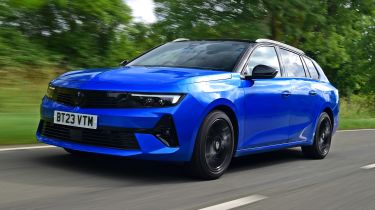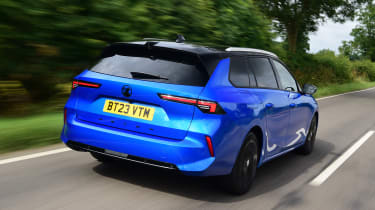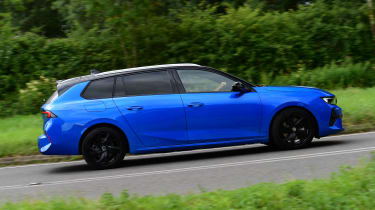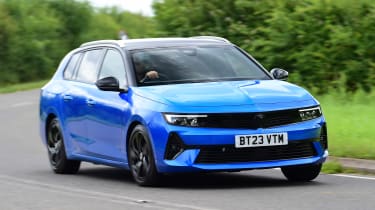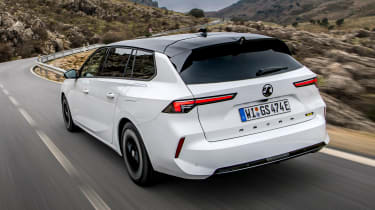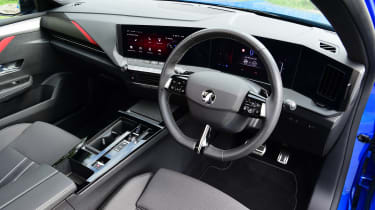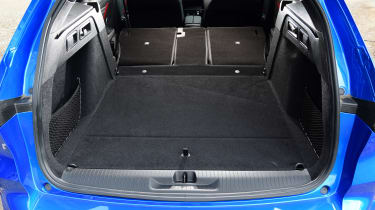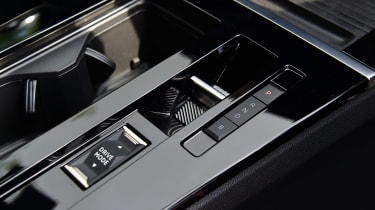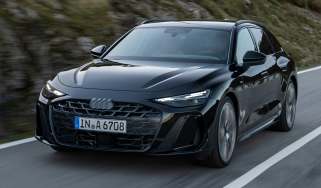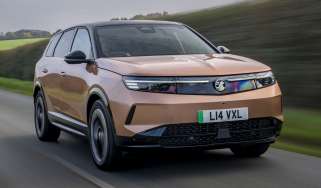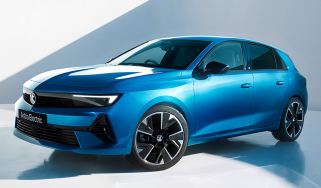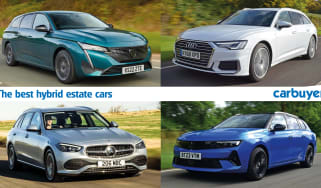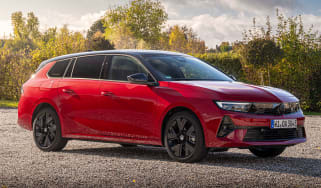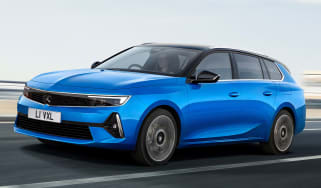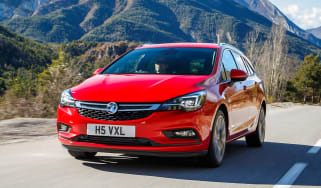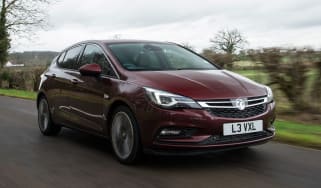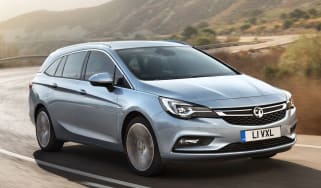Vauxhall Astra Sports Tourer review - versatile family estate
“More spacious than the Astra hatchback, the Sports Tourer ends up being a jack-of-all-trades, master of none”
Pros
- Choice of powertrains
- Practical
- Well equipped
Cons
- Can get pricey
- Firm ride with bigger wheels
- Reduced boot size for PHEV
Verdict - Is the Vauxhall Astra Sports Tourer a good car?
The Vauxhall Astra has long played second fiddle to desirable rivals like the Volkswagen Golf, while the Ford Focus has been a touch better to drive in the hatchback class. However, for this latest generation, the Astra looks handsome, and the driving experience is pretty sharp, too. The Sports Tourer estate offers almost 600 litres of boot space, while a choice of petrol and plug-in powertrains means there’s a version to suit most buyers.
Vauxhall Astra Sports Tourer models, specs and alternatives
The Vauxhall Astra is a household name in the brand’s lineup, now in its eighth generation. It’s all change for the family hatchback, though, with a striking new look and a range of fuel options, including petrol, hybrid and all-electric. It’s a similar tactic used for the smaller Vauxhall Corsa, which was one of the best-selling cars of 2023, while rivals such as the Ford Fiesta – which stuck with the more conventional petrol offering only – have been discontinued.
This new model features the same stylish looks as the Astra hatchback, but in a much more practical estate form factor. The wheelbase (the distance between the front and rear wheels) has grown by 57mm, and the biggest change is to the Astra’s rear end, where it now has a much larger boot than in the hatch. With 598 litres on offer, the Skoda Octavia Estate will still provide more cargo room with its 640-litre boot, however.
 Best estate cars on sale in 2025
Best estate cars on sale in 2025
Originally the Sports Tourer was only available as a petrol or hybrid model, but Vauxhall later released an electric version, making it one of the few electric estate cars on the market, alongside the Peugeot E-308 SW with which it shares many parts, and the MG5. The petrol and hybrid Astra Sports Tourer’s rivals are a little more plentiful, including cars such as the aforementioned Skoda Octavia Estate, Volkswagen Golf Estate, SEAT Leon Estate, Toyota Corolla Touring Sports and Ford Focus Estate.
More reviews
Buyers can configure their Sports Tourer in three trim levels: Design, GS and Ultimate – the range-topping Ultimate is no longer limited to the hatchback. All models come well equipped, however, with standard kit such as sat-nav, front-and-rear parking sensors, lane departure warning and autonomous emergency braking (AEB). GS Line cars get a sportier bodykit, dual-zone climate control and a 360-degree camera system. For keen drivers, there’s also the GSe version, which is the fastest Sports Tourer thanks to a more potent PHEV powertrain and upgraded chassis.
Sitting in the driver’s seat, you’ll be hard-pressed to tell the difference between the Sports Tourer and the hatchback. However, this is no bad thing as the Astra has a stylish interior, if not quite as premium-feeling as top rivals. The standard dual 10-inch screens in the front go a long way to making the new car feel hi-tech, while the estate’s longer wheelbase grants slightly more legroom for taller rear passengers.
Vauxhall has attempted to make the Astra feel sportier than the Peugeot 308 SW with which it shares its underpinnings. While the Sports Tourer is not quite as fun to drive as a SEAT Leon Estate, its stiffened suspension and tightened steering setup means it feels sharper through turns than the Peugeot – however, it isn’t quite as refined on longer motorway journeys. The GSe turns this up a notch further but sits in a rather small niche, being a quick-ish small estate instead of a proper performance car.
The Astra Sports Tourer’s engine lineup mirrors that of the hatchback, with petrol, diesel and plug-in variants on offer. The former will appeal to private buyers; we recommend the higher-powered 1.2-litre petrol here, to balance the Sports Tourer’s added bulk. The plug-in hybrid and all-electric versions will be the choice for company car drivers, however, with a 42-mile electric range for the PHEV and low Benefit-in-Kind (BiK) tax ratings.
MPG, running costs & CO2
In order for it to stand out amongst rivals, Vauxhall has tried to price the Astra Sports Tourer competitively; and it’s almost £2,000 cheaper than the equivalent Peugeot 308 SW. This will increase the Vauxhall’s appeal amongst private buyers, however, it will likely be an insignificant saving when it comes to monthly PCP payments, depending on the deals available at the time.
As with the Peugeot, the Vauxhall Astra Sports Tourer is available with petrol, plug-in hybrid and all-electric power, but diesel is no longer offered. The entry-level 1.2-litre three-cylinder petrol should be frugal enough for most buyers; Vauxhall claims it should return around 50mpg and emits between 123-134g/km of CO2. Buyers that specify the more powerful petrol unit will see similar figures, despite the extra punch from the engine.
If you are expecting to travel long distances frequently, then the 1.5-litre four-cylinder turbocharged diesel engine was a shrewd option, but it has been discontinued. This can return up to 60mpg and has CO2 emissions of around 122g/km. However, given its higher price tag over the petrol, this powertrain was something of a niche choice.
The plug-in hybrid (PHEV) model uses a petrol engine alongside an electric motor to return up to 256mpg, provided you keep the battery charged up. Speaking of which, this 12.4kWh unit provides a pure-electric range of up to 42 miles, dropping slightly to 39 miles for the GSe version. Recharging at a 7kW home box will take three hours, while a standard three-pin plug will charge the car in around seven.
The Astra Sports Tourer Electric has a claimed electric range of up to 255 miles to a charge, which should be enough for most buyers tackling shorter trips around town. It’s only down on the hatchback version by around five miles, despite the extra weight. It’s roughly on par with the MG5’s 250-mile figure, and a little up on the more expensive Peugeot E-308 SW’s 248 miles. In real-world conditions, we’d expect the Astra Sports Tourer’s range to sit closer to around 230-240 miles.
The Sports Tourer PHEV has low CO2 emissions of just 25g/km, while the Sports Tourer Electric releases zero emissions, so sits even lower in Benefit-In-Kind ratings. This results in low Benefit-in-Kind ratings, helping keep bills low. Unfortunately, however, the 39-mile range of the GSe means it sits in a slightly higher BiK band than the regular PHEV. All petrol Astra Sports Tourer models sit below the £40,000 VED threshold for car tax, meaning that buyers of petrol and diesel cars will pay the standard rate. Most plug-in hybrid and electric versions of the Astra Sports Tourer breach this threshold aside from the entry-level Design models.
Engines, drive & performance
While the standard version is by no means a hot estate car like the Cupra Leon Estate, the Vauxhall Astra Sports Tourer is fairly enjoyable to drive. It shares many of its parts with the Peugeot 308 and DS 4, however, Vauxhall has tinkered around with the Astra’s suspension setup to make it a bit sportier.
Through corners the Astra remains composed and suffers from little body roll. While the steering can feel a bit disconnected from the road at times, it is nicely weighted, but not to the point that it feels cumbersome.
The Sports Tourer’s petrol engine range comprises a single 1.2-litre three-cylinder turbocharged unit in two states of tune. The entry-level model produces 108bhp and can accelerate from 0-62mph in 10.8 seconds. For around an extra £500, the more powerful variant outputs 128bhp and reaches 62mph 0.8 seconds faster. While this may not seem like much of a difference, the extra punch makes the Astra feel a lot more at home on places like the motorway. Both come as standard with a six-speed manual transmission; the 128bhp model can also be specified with a smooth eight-speed automatic.
The plug-in hybrids are the most powerful versions of the Astra Sports Tourer currently available. The standard version uses a 1.6-litre three-cylinder petrol engine, alongside an electric motor to produce 178bhp, making it one of our top picks of the range. Getting from 0-62mph takes just 9.2 seconds; however, the added weight from the electric motor and batteries means the PHEV does not quite feel as spry as its petrol counterpart.
Throttle response and the automatic gearbox can feel slightly sluggish at times, and the entry-level PHEV actually feels at its best in town using its ‘Electric’ mode. The near-silent and smooth nature of the car in this guise feels the most impressive. When the petrol engine does kick in, it does so with a rather coarse engine note.
Vauxhall has also made the decision to use a PHEV powertrain in its hottest GSe-badged version, albeit now with 222bhp sent to the front wheels. This makes it respectably quick in a straight line, with 0-62mph coming up in just 7.6 seconds. However, the GSe’s main issue is weight – its electric motor and battery pack all add up, and the result is a small estate weighing around 1,750kg. That’s around the same weight as a seven-seat Skoda Kodiaq SUV, and the Astra doesn’t feel overly engaging along a twisting route as a result.
For the first time in its history, there’s now a fully-electric Vauxhall Astra Sports Tourer estate. It gets the same front-mounted electric motor with 154bhp as the hatchback and Peugeot E-308. All this power is only available once you set the Astra Sports Tourer Electric in Sport mode – throttle response feels more natural in this setting, whereas in Normal mode there’s a notable delay when you put your foot down compared to rivals. While there are many more powerful EVs, the Astra Sports Tourer Electric’s motor feels adequate enough, even in Normal mode.
It’s not a particularly fun car to drive, but even in estate guise, it feels more eager than a Volkswagen ID.3 through the corners, and more planted than the MG5.
Happily, the audible motor whine found in the smaller Corsa Electric is less noticeable in the Astra Electric. Refinement as a whole is much better in the Astra Sports Tourer Electric compared to its petrol and PHEV counterparts – power delivery is naturally much smoother, and the car feels more rigid as a result of tweaks to the car’s inner structure.
There was only one diesel: a 1.5-litre four-cylinder with 128bhp, but this is no longer offered. It could only be optioned with the eight-speed automatic gearbox and takes a leisurely eleven seconds to reach 62mph. However, thanks to plenty of torque low down in the rev range, it feels nippy when setting off from a standstill.
Interior & comfort
The latest Astra Sports Tourer is a big step up from the old model in terms of interior design. While not quite as distinctive as the cabin in the Peugeot 308, the Astra’s interior feels more ergonomic and has a much more comfortable driving position. Unfortunately, however, the Vauxhall can’t quite match its French rival in terms of interior quality; while the steering wheel and other frequent touch points feel relatively premium, there are several cheap-looking pieces of trim scattered about.
When you step inside, the first thing you’ll notice is the two 10-inch displays that are mounted on top of the dashboard. These act as the digital instrument cluster and infotainment touchscreen and come as standard on all models. Both are highly configurable and easy to use; Apple CarPlay and Android Auto come pre-loaded if you’d prefer to use your phone’s operating system over Vauxhall’s.
Where the Astra lags behind in the quality department, it remains strong in terms of standard equipment. There are three versions to choose from: Design, GS and Ultimate. The range kicks off with the Design trim; this comes with most of the kit you’d need such as 16-inch alloy wheels, LED headlights, sat-nav, air conditioning, front and rear parking sensors, lane departure warning and autonomous emergency braking.
The GS model is only available with the more powerful petrol engine, as well as the plug-in powertrains. On top of what is offered by Design trim, GS cars get sporty black exterior details with 17-inch black alloy wheels. The GS equipment list also includes a set of heated sport seats, dual-zone climate control, a 360-degree camera system, adaptive cruise control and traffic sign recognition.
Previously only offered for the hatchback, the Ultimate trim adds kit like 18-inch alloy wheels with black inserts, adaptive LED pixel headlights, an upgraded stereo, panoramic sunroof, powered tailgate, highly adjustable front seats and gloss back roof rails.
A Vauxhall Astra Sports Tourer GSe trim offers an even more sporting feel, thanks to a unique exterior makeover and set of alloy wheels, along with adaptive cruise control and Vauxhall’s IntelliLux adaptive headlights. Wireless Android Auto and Apple CarPlay also mean there’s no need for untidy USB cables.
Practicality & boot space
Relatively tight rear seats are one of the drawbacks of the Vauxhall Astra hatchback; adults sitting in the rear of that car quickly find that legroom is at a premium and their knees are digging into the seats in front. So, with the Sports Tourer’s longer wheelbase, has Vauxhall managed to rectify this issue?
In summary: yes and no. The increase in the car’s overall length hasn’t had as much of a drastic change as you might expect; however, there is now slightly more legroom in the rear. Nevertheless, if you intend to carry adults in the back frequently, you’re better off looking at something like a Volkswagen Golf Estate as headroom is tight for passengers over 6ft tall.
As for boot space, the Sports Tourer is much more practical than the hatchback. With 597 litres on offer, the estate’s boot is 177 litres larger than the standard Astra’s. However, compared with the likes of the 640-litre boot of the Skoda Octavia Estate, the Astra is only average for this class. Pick the plug-in hybrid or electric model and cargo volume drops from 597 litres to 516 litres – less than you’ll find in the similarly-named Toyota Corolla Touring Sports. The rear seats can be folded in a 40:20:40 split, however, opening up a cavernous 1,634 litres of room, or 1,553 in the plug-in hybrid or fully-electric version – that’s 186 litres more than that of an MG5.
The Astra Sports Tourer’s low load lip and wide boot opening makes getting larger and heavier items in and out much easier, and there are useful touches such as storage nets on the sides and tethering hooks to better secure items.
Reliability & safety
Vauxhall doesn’t have a squeaky-clean record when it comes to reliability, however, the brand’s recent partnership with Peugeot and Citroen under the Stellantis name should hopefully bring about more consistency in terms of build quality and reliability.
We had hoped Vauxhall’s 17th-place performance in our 2022 Driver Power customer satisfaction survey showed strong signs of this, but slipping back to 24th (out of 32 brands) in 2023 shows there’s still lots of work to do. The latest Astra is too new to have featured in the survey, but its larger sibling, the Vauxhall Grandland, placed a middling 52nd out of 75 cars.
The Astra and its mechanical twin, the Peugeot 308, both achieved four stars on the latest Euro NCAP safety test. The Astra scored 80% and 82% respectively for adult and child protection, only missing out on the coveted fifth star due to the lack of some safety features.
Regardless, all versions of the Astra Sports Tourer come fitted with lane departure warning, autonomous emergency braking and hill-start assist. Higher-end models also get traffic sign recognition, forward collision warning and 360-degree camera systems.
